new posts in all blogs
Viewing: Blog Posts Tagged with: kindling words, Most Recent at Top [Help]
Results 1 - 14 of 14
How to use this Page
You are viewing the most recent posts tagged with the words: kindling words in the JacketFlap blog reader. What is a tag? Think of a tag as a keyword or category label. Tags can both help you find posts on JacketFlap.com as well as provide an easy way for you to "remember" and classify posts for later recall. Try adding a tag yourself by clicking "Add a tag" below a post's header. Scroll down through the list of Recent Posts in the left column and click on a post title that sounds interesting. You can view all posts from a specific blog by clicking the Blog name in the right column, or you can click a 'More Posts from this Blog' link in any individual post.
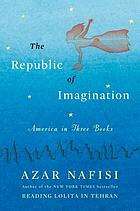 Azar Nafisi’s The Republic of Imagination is one of those not quite this not quite that sorts of books. By that I mean it is memoir but it isn’t and it is literary criticism but it isn’t. Sometimes it is more one than the other but throughout the personal is blended in with the literary. If you have read Reading Lolita in Tehran you will have an idea of what I mean. Only in this book, Nafisi talks much more in depth about the books.
Azar Nafisi’s The Republic of Imagination is one of those not quite this not quite that sorts of books. By that I mean it is memoir but it isn’t and it is literary criticism but it isn’t. Sometimes it is more one than the other but throughout the personal is blended in with the literary. If you have read Reading Lolita in Tehran you will have an idea of what I mean. Only in this book, Nafisi talks much more in depth about the books.
Nafisi became an American citizen in 2008. I was surprised to learn she attended university in the United States, the University of Oklahoma in Norman, Oklahoma. There she studied literature. She left her job teaching literature in Tehran in 1995 because she no longer felt she could teach it properly without attracting too much attention from the authorities. She remained in Tehran until 1997.
Republic of Imagination was inspired by a question she had from an earnest young Iranian man at a reading she gave in Seattle. He told her that Americans didn’t care about books and literature, that in Iran they cared much more and didn’t she feel she was wasting her time talking to people about literature? Nafisi of course disagreed and this book is her answer.
Nafisi focuses on three American novels, The Adventures of Huckleberry Finn by Mark Twain, Babbit by Sinclair Lewis, and The Heart is a Lonely Hunter by Carson McCullers with an epilogue in which she discusses the work of James Baldwin. She examines what each book says about the American character and mindset and why the book is important still. Into her examination of each of the novels she weaves personal stories about friends, attending university in Oklahoma, Iran. Some of her personal stories fit better with the book under discussion than others but they are all interesting even when there is a disconnect.
The chapter on Huck Finn is by far the longest, taking up nearly half the book. Nafisi is very attached to Huck and Mark Twain but she goes on far too long. Perhaps it is because she used to discuss Twain with a dear friend who died from cancer. Perhaps it is also because at the time she was planning on writing an entire book on Twain and Huckleberry Finn. As interesting as her discussion was, however, I felt myself drifting off about two-thirds of the way through the chapter, wondering what more she could possibly say that she hadn’t already and wishing we could just move on to the next book. Once she does move on, the pace picks up again.
As much as I enjoyed Republic of Imagination, and I did enjoy it very much, I don’t think Nafisi managed to provide a very good response to the Iranian man. If her intent was to prove the importance of literature to Americans, she failed completely. She does succeed in arguing that American literature has some important things to say and that it very often connects directly to real life.
Nafisi is clearly a woman who is passionate about books and literature and wants to share that passion with others. The book often reads like a conversation, though it sometimes veers into lecture. I can imagine sitting in a cafe with her talking books, her leaning forward and eagerly asking, oh what did you think about this part? and drinking way too much coffee in an attempt to keep up with her energy and leaps of thought. Not a bad book, not a great book but a good book, a very enjoyable book that makes you happy to be a reader.
Filed under:
Books,
Nonfiction,
Reviews Tagged:
Azar Nafisi,
Babbit,
Huckleberry Finn,
James Baldwin,
The Heart is a Lonely Hunter 

 Mark Twain‘s famous characters Tom Sawyer and Huckleberry Finn could star in a steampunk sequel to The Adventures of Huckleberry Finn. ABC has ordered a script for the possible show titled Finn & Sawyer.
Mark Twain‘s famous characters Tom Sawyer and Huckleberry Finn could star in a steampunk sequel to The Adventures of Huckleberry Finn. ABC has ordered a script for the possible show titled Finn & Sawyer.
The Hollywood Reporter has the scoop: “The drama hails from Detroit 1-8-7 duo Jason Richman and David Zabel and is described as an adventure-themed reinvention that revolves around the two famed literary characters who re-meet as young men in their 20s and form an investigative firm in a bustling and steampunk New Orleans.”
If you want to read Twain’s most famous novels, visit our Free eBook Flowchart to download free copies of the digital books. What is steampunk, you may ask? Follow this link to find out more about the genre. (E. W. Kemble illustration via the 1884 edition of Huckleberry Finn; link via i09)
New Career Opportunities Daily: The best jobs in media.

By: Kirsty,
on 7/18/2011
Blog:
OUPblog
(
Login to Add to MyJacketFlap)
JacketFlap tags:
Victorian,
Prose,
OWC,
vanity fair,
Huckleberry Finn,
oxford world's classics,
william makepeace thackeray,
*Featured,
John Sutherland,
becky sharp,
thackeray,
swartz,
Literature,
Add a tag
By John Sutherland
We can never know the Victorians as well as they knew themselves. Nor–however well we annotate our texts–can we read Victorian novels as responsively as Victorians read them. They, not we, own their fiction. Thackeray and his original readers shared a common ground so familiar that there was no need for it to be spelled out. The challenge for the modern reader is to reconstruct that background as fully as we can. To ‘Victorianize’ ourselves, one might say.
It goes beyond stripping out the furniture of everyday life (horses not motorised transport, no running hot water, rampant infectious diseases) into attitudes. Can we—to take one troublesome example—in reading, say, Vanity Fair, ‘Victorianize’ our contemporary feelings about race? Or should we accept the jolt that overt 19th-century racism gives the modern reader, take it on board, and analyse what lies behind it?
It crops up in the very opening pages of Vanity Fair. Thackeray’s first full-page illustration in the novel shows the coach carrying Amelia and Becky (she hurling her Johnson’s ‘Dixonary’ out of the window) from Miss Pinkerton’s to the freedom of Russell Square. Free, free at last. Looked at closely, we may also note a black footman riding postilion in the Sedley coach. He is, we later learn, called Sambo. He features a couple of times in the first numbers and his presence hints, obliquely, that the slave trade is one field of business that the two rich merchants, Mr Sedley and Mr Osborne, may have made money from. The trade was, of course, abolished by Wilberforce’s act in 1805, but slaves continued to work in the British West Indies on the sugar plantations until the 1830s. The opening chapters of Vanity Fair are set in 1813.
When we first encounter George Osborne and Dobbin, they are just back from the West Indies. What was their regiment doing? Protecting the British interest in sugar cane production in the Caribbean possessions of the Crown (it is, incidentally, the same crop which enriches Mr Rochester in Jane Eyre and the Bertram family in Jane Austen’s Mansfield Park; the English were addicted to sugar in their tea and cakes).
There is another character in the novel with an interest in the West Indies. Amelia’s and Becky’s schoolmate at Miss Pinkerton’s academy, Miss Swartz, is introduced as the rich woolly-haired mulatto from St. Kitt’s.’ St. Kitt’s, one of the Leeward Islands in the Caribbean, had (until well into the twentieth century) a monoculture economy based on one crop, sugar. The plantations were worked, until the mid-1830s, by slaves–of whom Miss Swartz’s mother must have been one. Dobbin’s and George’s regiment, the ‘—-th,’ has recently been garrisoned at St. Kitts just before we encounter them. One of their duties would be to put down the occasional slave rebellions.
Miss Swartz is, we deduce, the daughter of a sugar merchant (the name hints at Jewish paternity) who has consoled himself with a black concubine. This was normal practice. It was also something painfully familiar to Thackeray. His father had been a high-ranking official in the East India Company. Thackeray, we recall, was born in Calcutta and educated himself on money earned in India. Before marrying, Thackeray’s father, as was normal, had a ‘native’ mistress and by her an illegitimate daughter, Sarah Blechynden. It was an embarrassment to the novelist, who declined any relationship with his half-sister in later life. In the truly hideous depiction Thackeray made of Miss Swartz (he illustrated his fiction, of course) in chapter 21 (‘Miss Swartz Rehearsing for the Drawing-Room’) one may suspect spite and an element of sham
Just in case you missed 60 Minutes (on CBS) last weekend, Byron Pitts reported on the neverending “Huckleberry Finn” saga and the use of the word nigger. He did a great job by showing all aspects of the controversy. Take a look.
Since I was in high school, I have been on the fence as to whether or not Huck and To Kill A Mockingbird were books that I needed to read; but who wants to argue with a teacher? I am sure you can tell, nothing has changed for me since then. I still ask, are these books relevant? Are there other more contemporary books out there that students (and teachers) can learn from? As educators, it is incumbent on us to keep having conversations about today’s reading lists. Imho, reading lists should change. They actually need to change in an effort to cultivate a garden of new crops. Just imagine what life would be like if the Industrial Revolution didn’t begin – serve its purpose – then end? What happens if we keep these reading lists for another 100-years?
E-mail me: [email protected]
Follow me on Twitter: @abowllan
Find me on Facebook!

By: James Preller,
on 3/21/2011
Blog:
James Preller's Blog
(
Login to Add to MyJacketFlap)
JacketFlap tags:
Huckleberry Finn,
Elmore Leonard,
Jigsaw Jones,
Beatles references Jigsaw Jones,
Chili Palmer,
Frogs in children's literature,
Get Shorty,
how to catch a frog,
how to write detective stories,
Jamie Smith,
Jigsaw Jones #27,
Jim Smiley,
Slim Palmer,
stories behind the story preller,
Stringbean Noonan,
The Case of the Frog-Jumping Contest,
The Notorious Jumping Frog of Calaveras County,
Tioga Hills Elementary,
Twain influence,
the writing process,
Fan Mail,
Mark Twain,
Add a tag

There’s a little bit of Mark Twain in this book, mostly from two sources, his short story “The Notorious Jumping Frog of Calaveras County,” and, of course, his Huckleberry Finn character.

The story begins with a standard thriller device, the ticking bomb. Throw a deadline into a standard mystery and you immediately ratchet up the tension. In this case, look at the book’s opening paragraphs:
“My frog is missing,” croaked Stringbean Noonan. “And I MUST have him back by this Sunday at noon.”
“Sunday at noon?!” Mila exclaimed. “That’s only twenty-four hours from now.”
Stringbean stuffed two dollars into my coin jar. “There’s more where that came from,” he sniffed. “Just find that frog.”
Adonis, the missing frog, was no ordinary frog. (Love that name, btw.) He was a champion jumper with hops to spare, and there was a big frog-jumping contest coming up — with a $20 cash prize for the longest leap.
So already we’ve added motive to the mystery.
“Twenty dollars,” I whistled. “That’s a lot of money.”

I borrowed the first Twain idea in Chapter Five, “Want to Bet?” Most famously, there’s a character in Twain’s “The Notorious Jumping Frog from Calaveras County,” a noted gambler named Jim Smiley, who loves to bet. On anything. And everything. Twain describes him thus in the story:
“If he even seen a straddle bug start to go anywheres, he would bet you how long it would take him to get to — to wherever he going to, and if you took him up, he would foller that straddle bug to Mexico but what he would find out where he was bound for and how long he was on the road.”
Anyway, I reread the story during the brainstorming stages of the book, when I was casting about for ideas, so I decided to give that character trait to a minor character, Jigsaw’s classmate, Eddie Becker, who I had established in previous books as being highly motivated by money.
Eddie loved to bet — and there wasn’t anything in the world he wouldn’t bet on. Two birds might be sitting on a telephone line. Eddie would bet which one would fly away first. He’d bet on a ball game or the color of the next car that drove down the street. The weirder the bet, the happier he was. Eddie was just one of those guys who needed to keep things interesting. Regular life wasn’t quite enough for him. Nah, there had to be something riding on it.
Jigsaw and Eddie enjoy a friendly bet. Later Eddie casually mentions a new suspect, Sasha Mink (another name I love). With Adonis now out of the way, Sasha stands to win the frog-jumping contest with her entr
Political Cartoon by Nate Beeler, Washington ExaminerThere are no less than 454 news stories for today alone on the intended release of Mark Twain's
Adventures of Huckleberry Finn in a new edition in which the words “nigger,” "Injun," and "half-breed" are replaced with the more politically correct "slave," "Indian," and "half-blood." NewSouth Books, an Alabama Publisher, has drawn criticism from many fronts and has opened up debate that is ongoing and passionate.
Is this rewriting history, taking a revisionist approach, or is it making a great piece of American literature accessible to students who would otherwise not be able to study this book because schools are reluctant to use it?
The Rhode Show (Fox Providence) has done an excellent job of outlining what the buzz is all about.
One thing that all sides seem to agree on is that the word "nigger" makes us uncomfortable. Some scholars defend Twain's language, believing that his readers should feel uncomfortable since it shines a light on the historic treatment of blacks. People differ on whether the word should be used if it is within its historical context or whether it should be removed to soothe modern sensibilities. Professor Alan Gribben, a Twain scholar and editor of the NewSouth edition believes he is helping schools to be able to get this classic book back into the curriculum. According to
Publishers Weekly,
Twain himself defined a classic as "a book which people praise and don't read." Gribben believes that the offensive "n-word" is causing a generation of school children to be deprived of this important American book and that the sanitized edition would make it easier for parents and teachers to accept.
However Twain was angry even when changes in punctuation were made by an editor. Below is the forward from the original Huckleberry Finn. IN this book a number of dialects are used, to wit: the Missouri negro dialect; the extremest form of the backwoods Southwestern dialect; the ordinary ‘Pike County’ dialect; and four modified varieties of this last. The shadings have not been done in a hap- hazard fashion, or by guesswork; but painstakingly, and with the trustworthy guidance and support of personal familiarity with these several forms of speech. I make this explanation for the reason that without it many

By: Rebecca,
on 4/26/2010
Blog:
OUPblog
(
Login to Add to MyJacketFlap)
JacketFlap tags:
History,
Literature,
Current Events,
Mark Twain,
A-Featured,
Prose,
finn,
twain,
Huckleberry Finn,
Kenzaburo Oe,
Joseph Conrad,
World Literature,
Shelley Fisher Fishkin,
twain’s,
twain”,
huckleberry,
Add a tag
Shelley Fisher Fishkin, Professor of English and Director of American Studies at Stanford is editor of the 29-volume Oxford Mark Twain, and of The Mark Twain Anthology: Great Writers on His Life and Work (The Library of America), on which the comments that follow are based. She is also the author of From Fact to Fiction: Journalism and imaginative Writing in America, Was Huck Black? Mark Twain and African American Voices, Lighting Out for the Territory: Reflections on Mark Twain and American Culture, and A Historical Guide to Mark Twain. We asked Fishkin to contribute to the blog in honor of the centennial of Twain’s death.
Ernest Hemingway said in 1935 that “All modern American literature comes from one book by Mark Twain called Huckleberry Finn.” But these days, as scholars increasingly focus on transnational dimensions of American culture, perhaps it’s time to look at Twain’s impact on writing outside of America, as well. The fact that this year marks the centennial of Twain’s death, the 175th anniversary of his birth, and the 125th anniversary of the U.S. publication of his most celebrated book makes it a perfect time to widen our angle of vision.
If we set out to look for an American author most likely to achieve a world readership, we would be hard-pressed to find a less promising candidate than Mark Twain at the start of his career. The dialect and slang that filled the title story of first book, The Celebrated Jumping Frog of Calaveras County and Other Sketches, struck some early foreign readers as impenetrable. And if they found the dialect and slang of Twain’s first book hard to understand, the insults he hurled at them in Innocents Abroad were, as one German writer put it, “unforgivable.” But Twain broke out of the mold with such original freshness that many Europeans who justly could have been offended were intrigued instead. Indeed, I’ve determined that the first book published anywhere on Twain was published

By: Katie B.,
on 3/19/2010
Blog:
First Book
(
Login to Add to MyJacketFlap)
JacketFlap tags:
School Library Journal,
Books & Reading,
Authors & Illustrators,
Mark Twain,
Adam Rex,
Shel Silverstein,
Anne Shirley,
The Big Read,
HarperCollins Children's Books,
Huckleberry Finn,
Literacy Links and Articles,
National Endowment for the Arts,
March Madness,
NCAA,
Battle of the Kids' Books,
Author Name Pronunciation Guide,
Petrova Fossil,
The Adventures of Tom Sawyer,
Add a tag
Kids’ books: This ‘March Madness’ is literally playing by the book
“School Library Journal is sponsoring a “Battle of the Kids’ Books.” Patterned after the wildly popular NCAA March Madness, the “Battle of the Kids’ Books” pits 16 topnotch children’s books against each other and asks popular children’s-book authors to choose a winner.”
10 of the best: heroes from children’s fiction
Don’t miss this photo essay featuring 10 heroes and heroines from children’s fiction including Huckleberry Finn, Anne Shirley and Petrova Fossil.
All-New Shel Silverstein Poetry Collection Due in 2011
This week HarperCollins Children’s Books announced the fall 2011 release of a collection of never-before published Shel Silverstein poems and illustrations.
Alabama youth reading Mark Twain to promote literacy
Throughout Alabama, children, big kids and families are reading or re-reading Mark Twain’s The Adventures of Tom Sawyer as part of the National Endowment for the Arts’ event The Big Read.
Author Name Pronunciation Guide
Ever wondered how you pronounce tricky authors’ names? This site offers a collection of brief recordings of authors & illustrators saying their names. Check out the recording from Adam Rex, a favorite of First Book staff member and author Erica Perl.

It's not quite Thursday, but I'm feeling thankful for:
...SNOW!! We didn't get as much as expected (I think ![[info]](http://stat.livejournal.com/img/userinfo.gif) jbknowles stole it all when the storm swung to the south), but it's still beautiful, and the skiing will be great this weekend.
jbknowles stole it all when the storm swung to the south), but it's still beautiful, and the skiing will be great this weekend.
...the delete button on my keyboard. I just finished a rewrite of a chapter book that my agent said needed to lose some weight before it sees the light of day.
Before: 15,300 words
After: 9,988 words
(She was right, too. The new version is simpler, funnier, more universal, and more kid-friendly. One more revision pass, and I'll be ready send it off.)
...March Novel Madness, a get-moving, springtime writing project born at the Kindling Words retreat last month. My goal is going to be 5000 words per week, which should carry me to the end of my new middle grade novel. I'm especially thankful for the talented, organized, and fabulously fun Alison James, who sent out inspiration packages to the writers participating in MNM. Once I figured out that the lumpy envelope in today's mail wasn't anthrax, I was delighted to find a word count calendar and peanut M&Ms inside.
...a Map of the World to guide my March writing.

At one of Laurie Halse Anderson's Kindling Words workshops, she discussed the importance of setting details -- and how hard it can be to "see" those details when you're writing a contemporary novel. I have a much easier time with historical novels, when all the rich setting details come from my research on real places and time periods. What's a writer to do with a neighborhood she made up? Make a map? That's what several writers suggested to me, so I sat down with colored pencils and a huge piece of poster paper and mapped Zig's neighborhood.
It's all there -- the school, his best friend's house, the diner, the rock skipping spot...everything. Already, it's so much easier for me to envision the places that are part of his life. It was really, really fun. While I was drawing, I figured out something important about a secondary character's backstory and discovered some spots in the neighborhood I hadn't known about before. Try this strategy!
Bonus for writers with kids at home: They can do this right along with you. E spent two hours adding details to her map of our neighborhood while I worked on mine.
.jpg?picon=512)
By:
Pamela Ross,
on 1/31/2008
Blog:
Born to Write
(
Login to Add to MyJacketFlap)
JacketFlap tags:
chuck,
comedy,
kindling words,
table manners,
vintage educational flims,
kindling words,
table manners,
chuck,
vintage educational flims,
Add a tag
When you dine at the New England Culinary Institute, only the best will do.
Unfortunately, I was so busy working on my book I forgot how to dine among the good gentlemen and gentleladies of Kindling Words. I had to brush up on table manners before I walked into the dining room. No way was I going to be caught dead selecting the wrong fork in front of Gregory Maguire.
It's good to have good people looking out for you. My culinary consultant, Chuck, passed along these helpful, courteous hints-- and let me tell you, no one at Kindling noticed I was once a mouth-stuffer. ;>
Save this for future reference. You, too, could be guilty of putting your butter knife on the wrong plate.
This is how we do it: stretching the brain, putting fire in the fingertips, before the day begins


Since I'm short on time, I'll just point you to a couple other who have already posted about the weekend.
Pictures at ![[info]](http://stat.livejournal.com/img/userinfo.gif) halseanderson and
halseanderson and ![[info]](http://stat.livejournal.com/img/userinfo.gif) kmessner.
kmessner.
Cheryl has a recipe from another editor that's to die for.
Oh, and an unexpected highlight--I met the author of a picturebook I'd enjoyed as a kid! I never knew it was written by Patricia Thomas until I saw the book in the KW library and remembered that this was the book I'd been trying to remember all those years. (I'd thought it was Horton Hears a Who until I read that book and realized it was nothing like "Stand Back," Said the Elephant, "I'm Going to Sneeze!" which was a big favorite of mine. An elephant warns his friends that they'd better back up, and I think they do (I'll have to look at it again), but eventually he sneezes and just blows everybody away. It's so funny!
I'm home. Vermont was a dream come true. I didn't know how much I needed to kindle until I walked into the room and felt surrounded by soul comrades. My imagination is filled with so many images and reflections in this post-Kindling Words retreat state of mind. I wish I had a way to take it from here--pointing to head-- and put it here-- pointing to the screen. I believe we call this an info-dump in editorial circles.
Laurie Halse Anderson reached into a frightened place in my heart this weekend and found my faith again. She is my personal lightning bolt. May I be able to thank her one day for the gift of her words. To me and to us.
After our fireside readings Saturday night, we trudged through the soft snow to the traditional Kindling Words bonfire. My toes were cold despite my heavy boots and triple-layers of socks. But the companions and the music and the laughter and the spirit infused heat and light and love around the circle. I wrapped two pieces of paper into my gloved hands, closed my eyes, kissed the air and made offerings of these papers into the fire, praying for words to come true. My wishes danced slowly, sinking into the wood, and soon caught flame in the kindling. (It didn't hurt to be standing next to Jane Yolen while I made these wishes. Talk about a Fairy G-dmother in your midst.)
One wish was for me.
One was for all of you.
I shall return after I collect my thoughts.
Which are many.
Which are magical.
There's nothing better than being snowbound with writer friends. They bring out the best in me. Thank you, fellow Kindling friends, for dancing around the fire with me (and a special hug to Linda Sue Park for asking to sing Bruce's HUNGRY HEART with me... She knows the way to my heart, doesn't she?!) Long may the flames burn.

Well, I'm back from another wonderful, refreshing, rejuvenating, inspiring Kindling Words retreat. I can quite honestly say that KW saved my writing life the first time I went in January 2006. Back then I was miserable and depressed, having had several ideas for a second book rejected, and was starting to feel like the first book was a fluke and I'd never write another.
Thanks to some stellar advice from some wise and special writers (mostly during 6am workouts in the miniscule gym) I realized that I had to get back in touch with my process and write the book I needed to write, not what I was being told I should write.
So I did. I got a part-time day job to make ends meet, to remove a little bit of the desperation. And then I just wrote, without showing what I was working on to anyone. I worked on a novel based on a writing exercise Ellen Wittlinger had us do in her workshop. And that book became PURGE.
I spent a lot of this weekend working on the line edits and revisions for PURGE. I hadn't read it in many months, because I'd wanted to wait for the revision letter before I re-read it. The good news is that when I did read it again, I thought, "Wow. I can't believe I wrote this."
The bad news is that my next thought was: "Holy @##%^! I'll never be able to write something like that again."
But it's good to have insecure thoughts like that at a place like KW, because you're surrounded by extremely accomplished authors, most of whom will admit to feeling exactly the same way. As Laurie Halse Anderson, who lead the author strand, said, when she sits down to start a new book she realizes she lacks the tools to write that book. Every book requires a different tools. Some you might carry with you from a previous book, but inevitably you'll need to discover some new ones.
I love that image. I find it very comforting. I think I'll have to put it in neon letters above my workspace, every time I try to write another book.
Anyway, enough philosophy. I'll give you what you want, what you really, really want: PICTURES!!
This is one of my favorites:
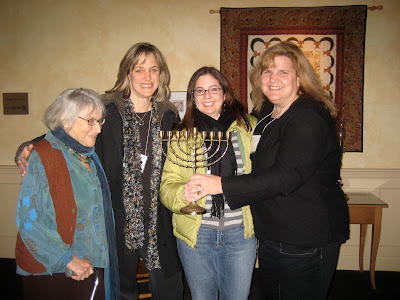
We were heading up to the hospitality suite for some late night socializing when in the foyer of this New England inn I spotted...a MENORAH!
Of course I to have a picture taken of Hebes and the Menorah - L to R you'll see the amazingly fabulous Vera Williams, Kim Marcus ![[info]](http://stat.livejournal.com/img/userinfo.gif) kmarcus, moi, and Pamela Ross
kmarcus, moi, and Pamela Ross ![[info]](http://stat.livejournal.com/img/userinfo.gif) writerross. It was so wonderful to meet livejournal friends Kim and Pam in "real life".
writerross. It was so wonderful to meet livejournal friends Kim and Pam in "real life".
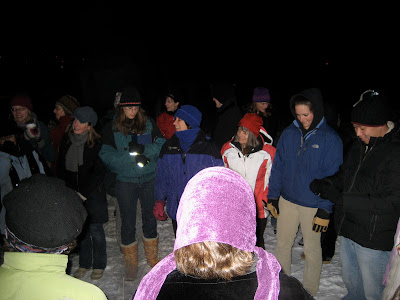
On Saturday night, after the candlelit readings, we trekked out to the bonfire pit to cast our wishes into the Universe. I won't tell you what my wish was, but I'll let you know if it comes true.
here's the amazing Laurie Halse Anderson ![[info]](http://stat.livejournal.com/img/userinfo.gif) halseanderson Nora Baskin, with whom I spent the 5 hours each way from CT to VT in the car talking non-stop, and the prolific and wise Jane Yolen. Jane gave me her name tag at the end of the retreat. I hope some of her talent rubs off.
halseanderson Nora Baskin, with whom I spent the 5 hours each way from CT to VT in the car talking non-stop, and the prolific and wise Jane Yolen. Jane gave me her name tag at the end of the retreat. I hope some of her talent rubs off.
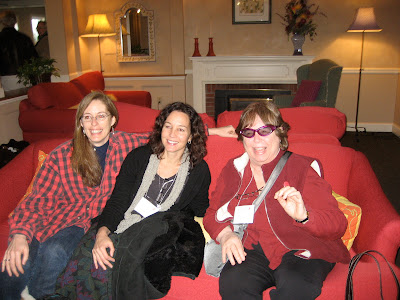
Did I say that Laurie is amazing? Well, it bears repeating. What you should know is that I only look like I'm almost as tall as she is because she was bending heavily at the knees.
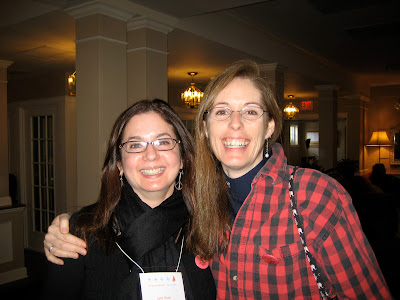
I was also thrilled to get the chance to meet the uber-cool and incredibly smart Cheryl Klein. I told her how psyched I was that she's going to be working with Gbemi (aka Mrs. Pilkington).

Ellen Wittlinger is the fairy godmother of my book PURGE. The pink button I'm wearing says " I look like myself" - Ellen had them made for her book PARROTFISH.
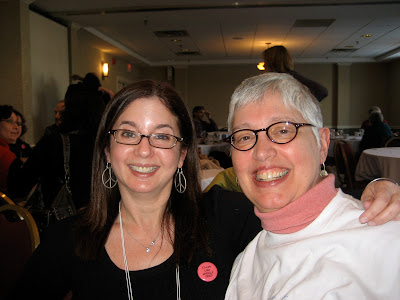
As always, I came home exhausted but inspired.
In other news, I'm happy to report that ![[info]](http://stat.livejournal.com/img/userinfo.gif) the_webmeister survived a weekend of looking after my children.
the_webmeister survived a weekend of looking after my children.
What do you get when you take 75 people who care passionately about writing, illustrating, and editing children's books, put them together for four days, feed them a lot, and build a blazing fire on a cold January night?
Magic.

I'm home from Kindling Words, full of inspiration, ideas, new friendships, and rich desserts. Homemade ice cream and pastries aside, this was an amazing weekend.
Laurie Halse Anderson's author strand on character and plot and Linda Sue Park's talk on scene as the bedrock for story were inspirational and immediately practical. When I sat down to write after each session, it felt like Laurie and Linda Sue were there over my shoulder, whispering in my ear, "Remember, make him uncomfortable..." and "Do you really want all that internal monologue?" (Linda-Sue-Over-My-Shoulder thought not, so I cut a lot of it.)
The retreat also left room for informal "white space" discussions, and I had the chance to connect with friends and meet so many amazing, talented writers, illustrators, and editors whose work I've admired for so long.
 Jane Yolen
Jane Yolen and
Linda Sue Park catching up in the lobby...

I was thrilled to see Rochester Book Festival pals
Kathleen Blasi (left) and
Sibby Falk (right), and just as excited to meet
Cinda Williams Chima (center), who not only writes but sings beautifully, too.
Hey,
![[info]](http://stat.livejournal.com/img/userinfo.gif) elizabethcbunce
elizabethcbunce... Look who else I met!
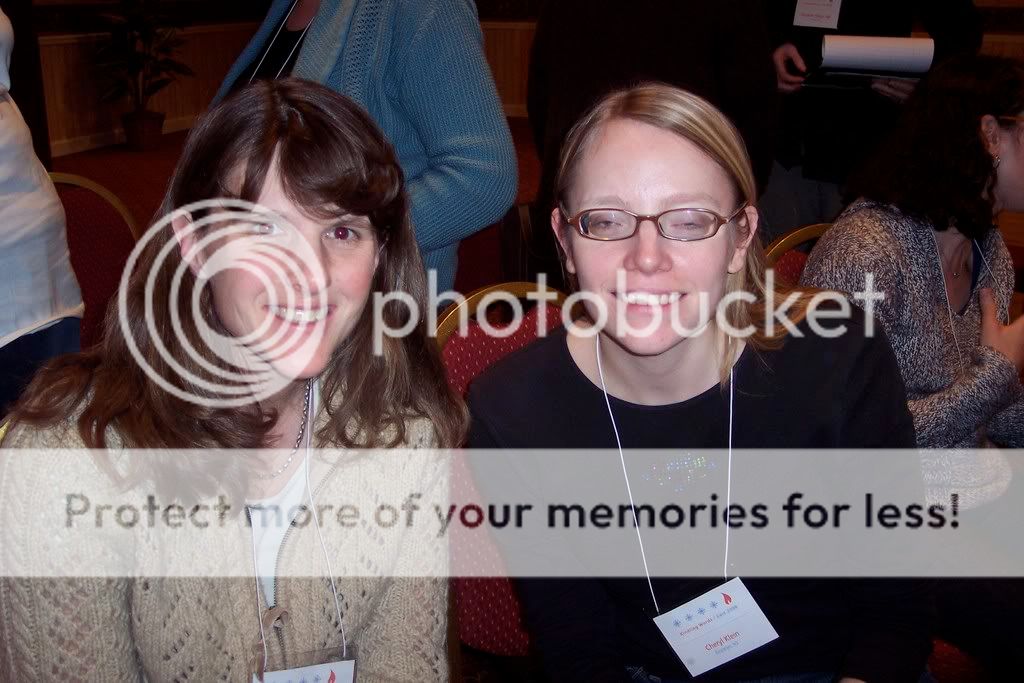
That's me on the left, next to
Cheryl Klein, Elizabeth's editor for
A Curse Dark As Gold, which comes out in March. I enjoyed chatting with Cheryl because we discussed weighty matters like books and whether chocolate or caramel sauce would be better on the brownie sundaes.
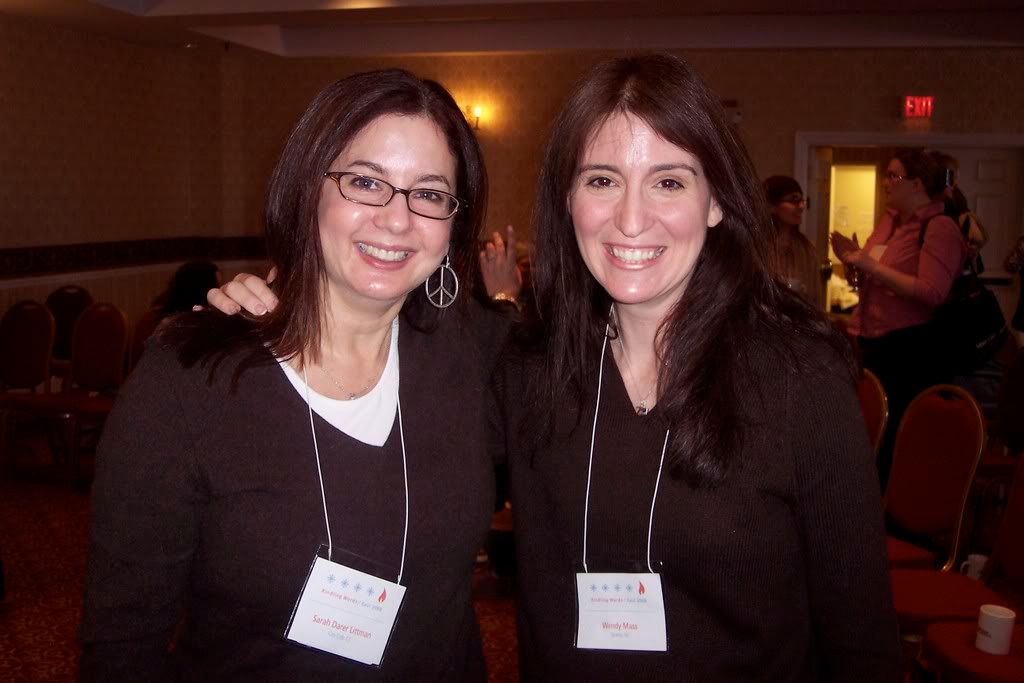
Here's LJ pal
Sarah Darer Littman (
![[info]](http://stat.livejournal.com/img/userinfo.gif) saraclaradara
saraclaradara) with
Wendy Mass...

...along with Laurie Halse Anderson, Linda Sue Park, and
Gregory McGuire.
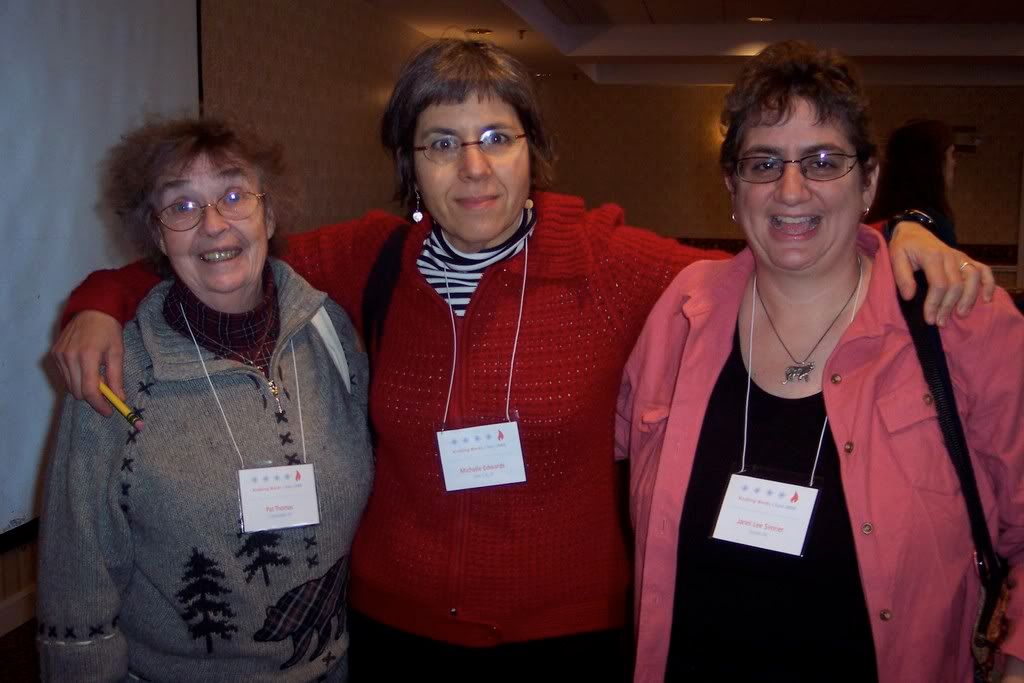
Patricia Thomas (left) celebrated her birthday at KW on Sunday. That's
Michelle Edwards in the middle and
Janni Lee Simner (
![[info]](http://stat.livejournal.com/img/userinfo.gif) janni
janni) on the right. Janni's stories about Iceland make me want to book a flight there immediately.

I also met
Katie Davis for the first time and was in awe of her energy. I've been called hyperactive. Katie makes me look like I'm standing still.

And here's
Donna Freitas with
Sara Zarr. I emailed Sara back and forth a couple times this month because I'm hosting a stop on her blog tour, but it was just last week that we figured out we were both going to the same retreat. It was fantastic to chat with her in person.
It might sound sappy to say it, but everyone was nice here. And interesting. And talented. Everyone. I wish I had photos of each person whose path crossed mine over the past four days. (If you're a fellow retreater and I didn't catch you before the blog-cam ran out of batteries, please know that I loved meeting you, too!)
Here's a huge group shot from the Kindling Words Caravan at Phoenix Books. More than 40 authors & illustrators signed books for kids and their families Thursday night.

Super thanks to Natacha, Renee, & Mike at Phoenix for taking on this enormous event!

I made one more cold and shaky attempt at a group photo during the actual retreat. (Be gentle with the photography criticism. It was dark and I had climbed onto a big slippery rock.)
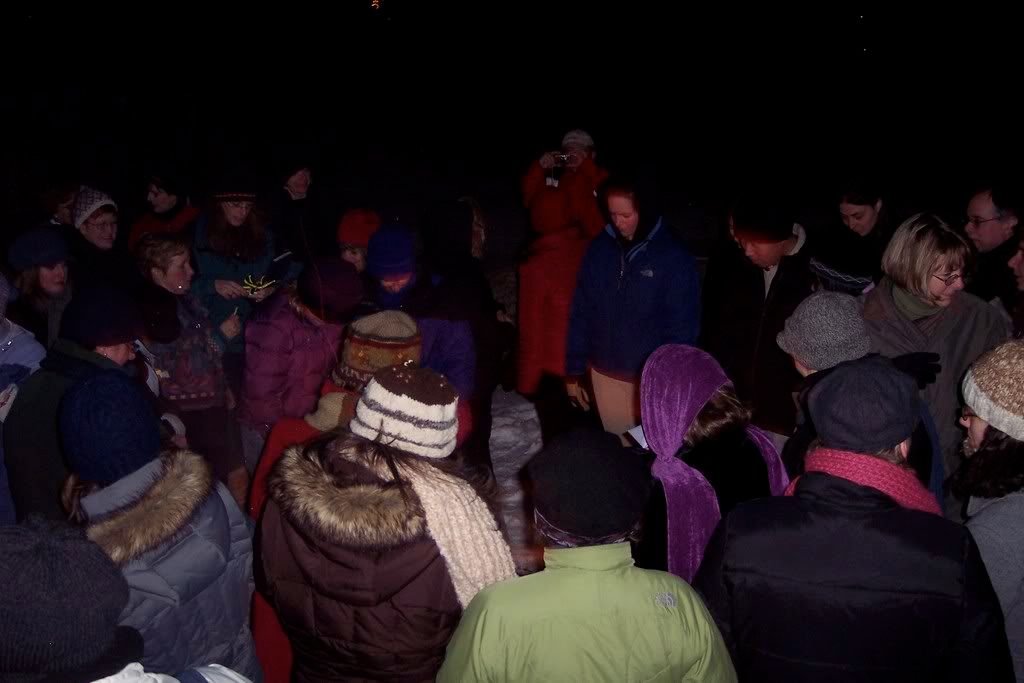
Here we are, all bundled up for the traditional KW bonfire. There's a longstanding tradition here that retreat-goers write down something on a piece of paper -- something they need to let go of, or a wish -- and then drop it into the flames.
On the way to the fire, one author worried aloud about people putting them both in the same fire. What if you wrote the title of your novel on the paper as a wish that it would sell, but the Universe thought you wanted it gone and erased your hard drive while you were off roasting marshmallows? I suggested that the bad things would all filter quietly down into the ashes, while the good things were carried off on the smoke to the writing goddesses. Maybe, she said. Then she labeled her paper WISH, with an arrow pointing to it. Just in case.
Here's my wish on its way to the flames...

I won't tell you what it said, but I'll let you know at the end of 2008 if it came true.
I'll share some other wishes, though -- staying in touch with the wonderful people I met this week and returning to fan the flames at Kindling Words again. It was truly a magical gathering of wisdom, wishes, and words.
 Azar Nafisi’s The Republic of Imagination is one of those not quite this not quite that sorts of books. By that I mean it is memoir but it isn’t and it is literary criticism but it isn’t. Sometimes it is more one than the other but throughout the personal is blended in with the literary. If you have read Reading Lolita in Tehran you will have an idea of what I mean. Only in this book, Nafisi talks much more in depth about the books.
Azar Nafisi’s The Republic of Imagination is one of those not quite this not quite that sorts of books. By that I mean it is memoir but it isn’t and it is literary criticism but it isn’t. Sometimes it is more one than the other but throughout the personal is blended in with the literary. If you have read Reading Lolita in Tehran you will have an idea of what I mean. Only in this book, Nafisi talks much more in depth about the books.


 Mark Twain‘s famous characters Tom Sawyer and Huckleberry Finn
Mark Twain‘s famous characters Tom Sawyer and Huckleberry Finn 

















